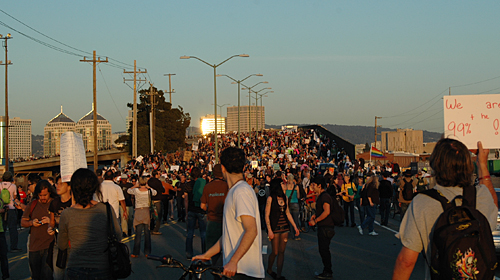Ready to Occupy? What You Need to Know about H.R. 347, the "Criminalizing Protest" Law


Spring has sprung, the grass is riz . . . and the Occupy movement is about to ramp up again. Activists recently announced a general strike for May 1, and protests are expected at the NATO summit on May 20 in Chicago. Later, of course, we can expect demonstrations in connection with the Republican National Convention in Tampa in late August and the Democratic National Convention in Charlotte in early September.
Last month, I wrote about a then-little known bill designated H.R. 347 and titled the "Federal Restricted Buildings and Grounds Improvement Act of 2011." The law, signed by the president in mid-March, expands an existing statute that criminalizes certain activity in and around areas that are restricted by the Secret Service.
Given the approaching protests, it may be worth providing a more detail on how exactly the law works, and what protesters can expect. Preliminarily, it's important to define one particular term in the law: "restricted buildings or grounds." These are specific geographic zones that have been designated by the Secret Service, and can be located under H.R. 347 in three places:
• The White House or the vice president's residence.
• A building or area where any individual under Secret Service protection is visiting.
• A building or area at which a National Special Security Event (or "NSSE") is taking place (more on that in a second).
Under the existing statute, four types of activities were illegal with respect to these zones, and remain so under the new law:
• You cannot "knowingly" enter or remain in a restricted zone without lawful authority.
• You cannot "knowingly" engage in "disorderly or disruptive" conduct in or near a restricted zone. A prosecutor would have to show, however, that you intended to disrupt government business and that your conduct actually did cause a disruption. Troublingly, the term "disorderly or disruptive conduct" is undefined.
• You cannot "knowingly" block the entrance or exit of one of these restricted zones. Again, however, the prosecutor would have to show that you did so with the intent to disrupt government business.
• Finally, you cannot "knowingly" engage in an act of physical violence against person or property in one of these restricted zones.
You'll notice that "knowingly" is in quotation marks above. This is one of the two major changes to existing law (the other is the extension of the statute to the White House and VP's residence). Previously, the law required someone to act "willfully and knowingly." This is the state of mind the government has to prove you had to establish your guilt (the "intent standard"). "Willfully and knowingly" means that you need to know you're committing a crime. "Knowingly" just means you need to be aware you're in a restricted zone, but not necessarily that it's unlawful.
(Incidentally, the punishment can be relatively severe. If you commit the offense with a weapon or if you cause injury (a felony), it can carry a maximum sentence of 10 years in prison and a fine of $250,000. Otherwise, the maximum is one year in prison and a fine of up to $100,000.)
There are a couple of other details worth noting to understand the full scope of the law. First, the Secret Service does not just protect the president and vice president. Rather, the agency has the responsibility for protecting the president, vice president and their immediate families; former presidents, vice presidents and certain family members; certain foreign dignitaries; major presidential and vice presidential candidates (within 120 days of an election); and other individuals as designated by a presidential executive order. If any of these individuals are temporarily visiting a location, this law kicks in.
Also, lots of attention has been paid to the National Special Security Events, which include things like presidential inaugurations, nominating conventions and even large spectacles like the Super Bowl. The Department of Homeland Security has massive discretion (which in and of itself is a problem) to designate one of these events as an NSSE based on things like the expected number of attendees and the presence of dignitaries.
So, what does this mean for lawful protesters? The honest answer is we simply don't know yet. These zones will hopefully occupy (no pun intended) a very small footprint at the three types of locations covered by the law. Also, these areas must be clearly identified to prevent protesters from inadvertently violating the law (or else they can't form the required intent). That said, the provision covering disruptions in or near the secure zones is of concern and could be misused to stifle lawful protest; same with the entrance/exit provision. These were already in the law, but the "knowingly" change could make them easier to abuse.
So far, we haven't seen any evidence that H.R. 347 specifically is being deployed aggressively by the Secret Service to tamp down on protests by Occupy or anyone else. That said, with the coming of spring 2012 and the November election, protest activity is undoubtedly going to grow rapidly. We'll be vigilant at the ACLU for any abuse, misuse or overuse, and we urge anyone who knows of any arrests or prosecutions under the new law to let us know.
Learn more about protestors' rights: Sign up for breaking news alerts, follow us on Twitter, and like us on Facebook.


